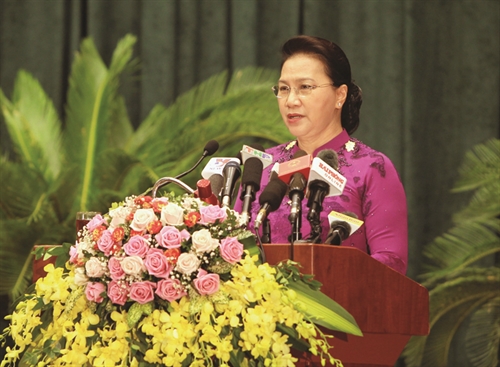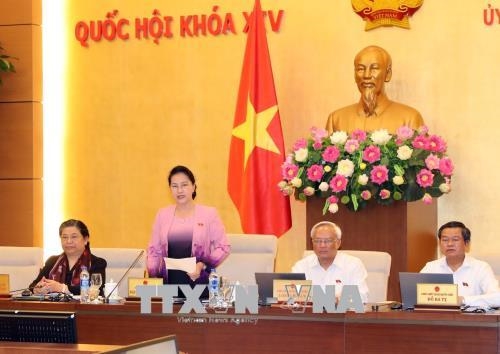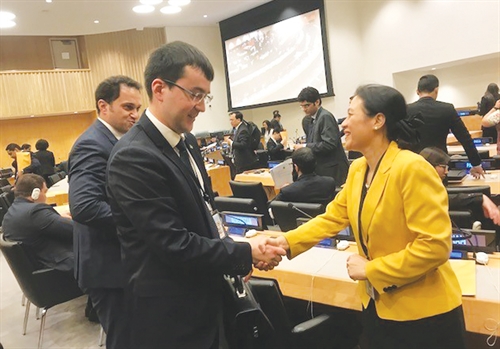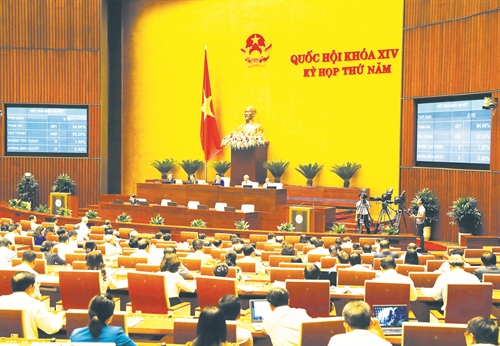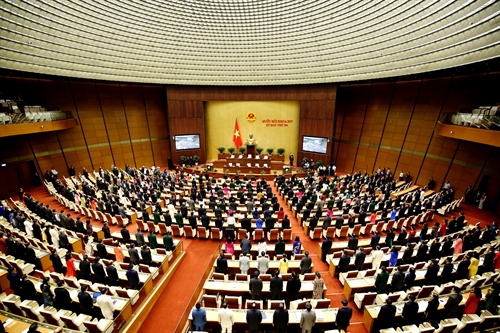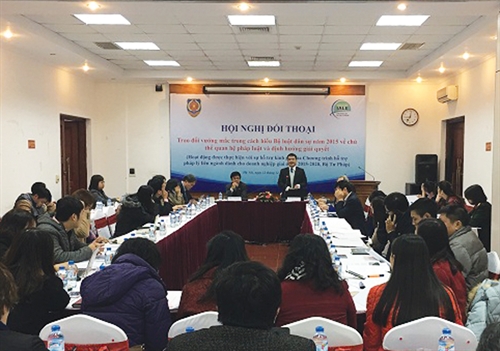Environmental protection law plays a crucial role in protecting the environment and promoting sustainable development in Vietnam. The author points out existing loopholes in Vietnam’s current regulations concerning environmental pollution control and puts forward proposals for tackling them in the coming time.
Dr. Bui Duc Hien
Institute of State and Law
Environmental protection is an important pillar of sustainable development. No country can develop sustainably without paying attention to environmental protection. After over 30 years of reform and opening up for economic development, Vietnam has gained numerous socio-economic achievements. Nevertheless, the country has to face the dark side of the market economy, including rich-poor gap, corruption, severe environmental pollution and degradation that greatly affect the people’s life, health and production, and sustainable development. In order to protect the environment and promote sustainable development in Vietnam, developing the market economy institutions in general and improving the legal institutions on environmental protection in particular plays a crucial role.
Vietnam’s current legal institution on environmental protection
Legal institutions are understood in Vietnam as regulations set out by state institutions to regulate the organization and operation of institutions and operation of the society. Environmental pollution control refers to the process of preventing, detecting, stopping and treating environmental pollution[1]. Thus, the legal institution on environmental pollution control can be defined as a body of regulations promulgated by state agencies or competent persons to determine the organization and operation of state agencies, responsible persons, organizations and individuals in preventing, detecting, stopping and treating environmental pollution. Assessment of the current legal institution on environmental pollution control in Vietnam should be conducted using the criteria of comprehensiveness, synchronism, consistency, publicity, transparency, feasibility, understandability and accessibility. Meanwhile, regulations on the organization and operation of environmental protection institutions should ensure effectiveness, efficiency, promptness, timeliness, publicity, transparency and supervision by the society.
To concretize the right to live in a clean environment prescribed in Article 43 of the 2013 Constitution and Article 4 of the 2014 Law on Environmental Protection (LEP), the Vietnamese state has issued a large number of legal documents aiming to effectively control environmental pollution. These documents include the 2014 LEP, Decree 18 of 2015 on environmental protection master plan, strategic environmental assessment, environmental impact assessment and environmental protection plan, Decree 19 of 2015 detailing the 2014 LEP, Decree 38 of 2015 on the management of wastes and scraps, Decree 164 of 2016 on environmental protection charge for mineral exploitation, and Decree 155 of 2016 on sanctioning of administrative violations in the field of environmental protection, to name but a few. They specify the responsibilities of state agencies, competent persons, organizations and individuals in formulating and implementing environmental technical regulations and standards, environmental protection master plans and plans, strategic environmental assessment, environmental impact assessment, environmental protection and waste management plans. They also address the detection of environmental pollution, ranging from environmental inspection, environmental observation and environmental information to prevention of environmental pollution, pollution tackling, environmental rehabilitation and handling of environment polluters. However, the actual environmental pollution control in the country in recent years has exposed a number inadequacies and loopholes in the current legal institution.
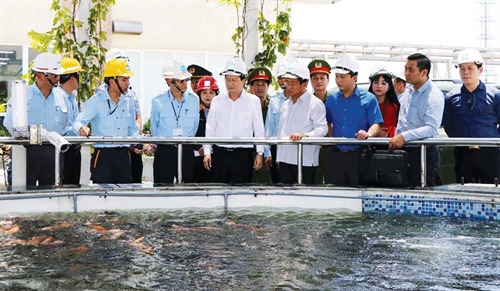 |
| Deputy Prime Minister Trinh Dinh Dung inspects the automatic wastewater discharge monitoring system of Formosa Corporation __Photo: Cong Tuong/VNA |
The first loophole is found in environmental technical regulations and environmental standards. Environmental technical regulations are considered the backbone of the law on environmental pollution control. However, in Vietnam a lot of them were issued more than 10 years ago, which contain many environmental indicators that are no longer suitable to the present situation or much lower than the standards currently applied by other countries in the region and the world. For example, Vietnam is currently applying the emission regulation for motorbikes equivalent to EURO 3; meanwhile, Singapore or European countries have applied the EURO 6 emission regulation[2]. Vietnam even has no environmental technical regulations at all in some fields, such as regulations on indoor air quality, technical regulations on odor and smoke, environmental technical regulations in agriculture and services, etc. This has caused difficulties to environmental pollution control and international integration.
The second inadequacy lies in planning work - the most important issue in environmental protection and sustainable development of the country. Environmental protection planning has been addressed in the 2014 LEP. However, there remain inconsistencies in the process, procedures and competence of formulation, appraisal, approval and implementation of the environmental protection master plan and other master plans on socio-economic development, land use, transport and urban centers. For example, as regards planning levels, the LEP sets out two levels, including national and provincial master plans on environmental protection; meanwhile, the Land Law provides 3 levels of land use planning: national, provincial and district. Such differences have led to overlapping planning contents, causing a waste of resources used for formulating and approving master plans and difficulties to their implementation.
The third inadequacy is observed in environmental assessment regulations. Environmental assessment covers analysis and forecast of environmental impacts of socio-economic development strategies, master plans and plans, specific investment projects and small-scale production and business activities, so as to work out solutions for environmental protection and sustainable development. These assessments are required to be conducted before socio-economic development strategies and master plans, investment projects and production and business activities are approved by competent state agencies. Environmental assessment has been provided in great detail in the 2014 LEP and Decree 18 of 2015 guiding the making of environmental assessment reports and environmental protection plans. However, there remain many problems in the actual implementation of these provisions, such as formalistic formulation and appraisal of environmental impact assessment reports; unhandled violations in the implementation of these reports…, which reduces the effectiveness of environmental pollution control.
The fourth inadequacy is seen in regulations on sectors and business lines prioritized for investment. It is universally recognized that environmental pollution is mainly caused by economic activity. Hence, in order to control pollution, it is necessary to draw up a list of environmentally friendly sectors prioritized for investment and a list of pollution-prone sectors which are banned or restricted from investment.
Vietnam’s strategy on sustainable socio-economic development during 2011-20 published in 2012 has stressed the policy to attract further investment in environmentally friendly fields, sectors and business lines. But the practical situation is another story. Licenses offering huge incentives have been still granted for pollution-prone sectors like mining, ship building, cast iron, steel, chemical and fertilizer production, leading to the infamous cases of Formosa steel production in Ha Tinh province and bauxite mining in the Central Highlands. These cases exposed not only shortcomings in the selection of projects calling for investment but also loopholes in regulations on the liability to compensate for environmental damage, from penal liability, administrative liability, disciplinary liability to civil liability of polluters; the role of the community and mass media[3] as well as responsibilities of state agencies and competent persons[4] in environmental pollution control.
The fifth inadequacy is related to waste management. Waste management is a very important stage in environmental pollution control, which is specifically provided in the 2014 LEP, Decree 38 of 2015 on waste and scrap management and other relevant legal documents. However, current regulations on waste management and their enforcement do not regard ordinary wastes as a type of resource in need of effective recycling and reuse[5]. Moreover, they still permit the import of scraps, which are in nature wastes, so they have been abused to import marine pollutants, thus turning Vietnam into a dumping site[6]. These regulations should be amended regarding ordinary wastes as a resource and strictly controlling, even banning, the import of scraps.
The sixth loophole is found in environmental inspection regulations, which are incorporated in the 2014 LEP, the 2010 Inspection Law, and Decree 35 of 2009 on the organization and operation of the environmental inspectorate. As per the Inspection Law, there are three types of inspection, namely administrative inspection, specialized inspection and people’s inspection. In the environment sector, the inspectorate of the Ministry of Natural Resources and Environment performs both administrative and specialized inspections; and the inspectorate of the Vietnam Environment Administration may inspect activities of state agencies and competent persons as well as owners of waste-discharging sources, and have competence to impose sanctions for environment law violators. However, activities of these environmental inspectorates in Vietnam still fail to satisfy practical requirements. In most cases, inspectors only detect an environmental pollution incident when it has already occurred and affected the people’s life and health. In the time to come, it is therefore necessary to revise regulations to increase the effectiveness of environmental inspection work.
The seventh loophole is seen in regulations on legal liability of polluters. Under Vietnamese law, based on the severity of violation, a polluter must bear a different type of legal liability, including administrative liability, penal liability, civil liability and disciplinary liability.
Over the past years, the country’s soil, water and air environments have been seriously polluted, affecting the people’s health, life, property and legitimate interests. However, the regulations on administrative sanctions against polluting acts in Decree 155 of 2016 remain not so stringent enough to deter violators. Meanwhile, although the 1999 Penal Code criminalized environmental pollution acts and the 2015 Penal Code, amended in 2017, holds legal entities criminally liable for committing polluting acts, no individuals or organizations have been so far criminally charged for these acts.
In addition, regulations on liability to compensate for environmental damage remain inadequate. Decree 03 of 2015 has provided that competent state agencies have the duty to request compensation for environmental damage but such provision has not been implemented ineffectively. At the same time, provisions in the 2015 Civil Code and the 2014 LEP on compensation for damages caused by environmental pollution to the health, life, property and legitimate interests of individuals and organizations are difficult to implement. In fact, there has never been a case of claim for compensation for environmental damage solved at the court. Current regulations also hinder individuals and organizations from claiming compensation for damages because it is very hard to prove the causal relationship between the polluting acts and the damage caused. In reality there are many cases where environmental pollution is believed to cause diseases and deaths to people but they were unable to receive compensations. The typical case occurred in Thach Son commune, Lam Thao district, Phu Tho province, where, as confirmed by the Ministry of Health, the number of deaths from cancer is highest nationwide[7], and the land, water and air are seriously polluted, according to the Ministry of Natural Resources and Environment[8]. However, no responsible agency has made a conclusion that such cancer was caused by environmental pollution, leaving local people unable to receive satisfactory compensation. For now, they are only provided with access to clean water and health insurance. Besides, the responsibility of state officials and civil servants for environment-related violations has not yet been thoroughly handled, reducing the effectiveness of the state management of the environment.
The last inadequacy is found in regulations on the responsibilities of state agencies and competent persons for environmental pollution control. Current environmental regulations have clearly identified the environmental pollution management responsibilities of the Government and provincial-, district- and commune-level People’s Committees, as well as of the Ministry of Natural Resources and Environment, Ministry of Transport, Ministry of Construction and local specialized departments. However, despite the involvement of so many agencies, Vietnam’s environment has become more and more seriously polluted in the past years, demonstrating the low effectiveness in the state management of the environment. Meanwhile, the supervision by the state as well as the community and the press over activities of state management agencies in charge of environmental protection and owners of waste-generating sources remains unsatisfactory.
Orientations and solutions for improving the legal institution on environmental pollution control in the coming time
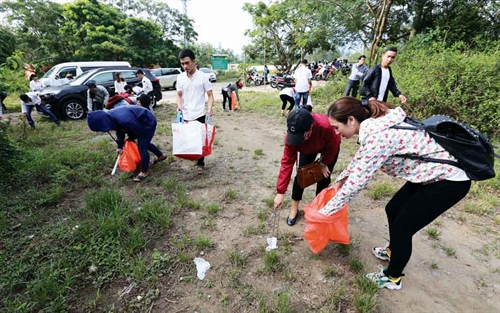 |
| People clean up tourist attractions in Son Tra peninsula, Da Nang city__Photo: Tran Le Lam/VNA |
First, the improvement of the legal institution on environmental pollution control should be approached from the viewpoint of guaranteeing human rights. Article 43 of the 2013 Constitution and Article 4 of the 2014 LEP have asserted that everyone has the right to live in a clean environment. This issue is of much greater meaning in the context that Vietnam is building a law-governed state that attaches importance to protecting human rights based on the supremacy of law.
Second, efforts should be based on Vietnam’s strategy on sustainable development, since environmental protection is an important pillar of sustainable development alongside with the pillars of economic development and social development. The legal institution on environmental pollution control must be closely, appropriately and harmoniously combined with the ones on economic development and social development.
Third, the legal institution on environmental pollution control must conform with the treaties pertaining to environmental protection to which Vietnam is a contracting party, such as the Paris Agreement on Climate Change, the EU-Vietnam Free Trade Agreement and the Comprehensive and Progressive Trans-Pacific Partnership (CPTPP) Agreement, among others[9], since the environmental protection standards set out in these treaties are global values that all nations should strive for. Reaching these standards will help Vietnam more deeply integrate in the region and the world. Vietnam should also promote international cooperation on environmental protection to make use of capital, experience and technology to protect its environment.
Fourth, it is necessary to apply effectively the achievements of the fourth Industrial Revolution, particularly the 3D-printing technology, artificial intelligence (AI), Internet of Things (IoT), cloud computing and nano materials, among others, to the prevention, detection, protection and handling of environmental pollution[10].
Fifth, Vietnam’s legal institution on environmental protection should be based on the master plan on socio-economic development and take into account all of the master plans on land use, urban areas, transport, biodiversity preservation and environmental protection for a long-term vision. Besides, it is necessary to put into place a complete and synchronous system of environmental technical regulations in conformity with regional and international regulations and Vietnam’s socio-economic development level.
Based on these orientations, the improvement of the legal institution on environmental protection should clearly define the functions, tasks and powers of state agencies and competent persons in the state management of the environment, as well as their legal liability for violations committed. The current involvement of too many state agencies in controlling environmental pollution has made the issue a nobody’s business. A solution to this problem is that this work should be assigned to specialized environment agencies as a focal point, such as the Ministry of Natural Resources and Environment. At the same time, the responsibility of heads of state agencies for controlling environmental pollution should be enhanced. The building of the apparatus and personnel of these agencies should be based on the supply and demand rule, meaning that the establishment of these agencies and the recruitment of their personnel should be based on practical requirements and they should be dissolved if they are no longer needed or operate ineffectively. In addition, it is necessary to improve regulations on the participation of the community, mass media and social organizations in supervising the operation of state agencies in general and entities in charge of state management of the environment in particular and in detecting environment-polluting and -degrading acts. Last but not least, the above-mentioned inadequacies, loopholes and shortcomings in the regulations on environmental pollution control and their enforcement should also be thoroughly addressed.-

